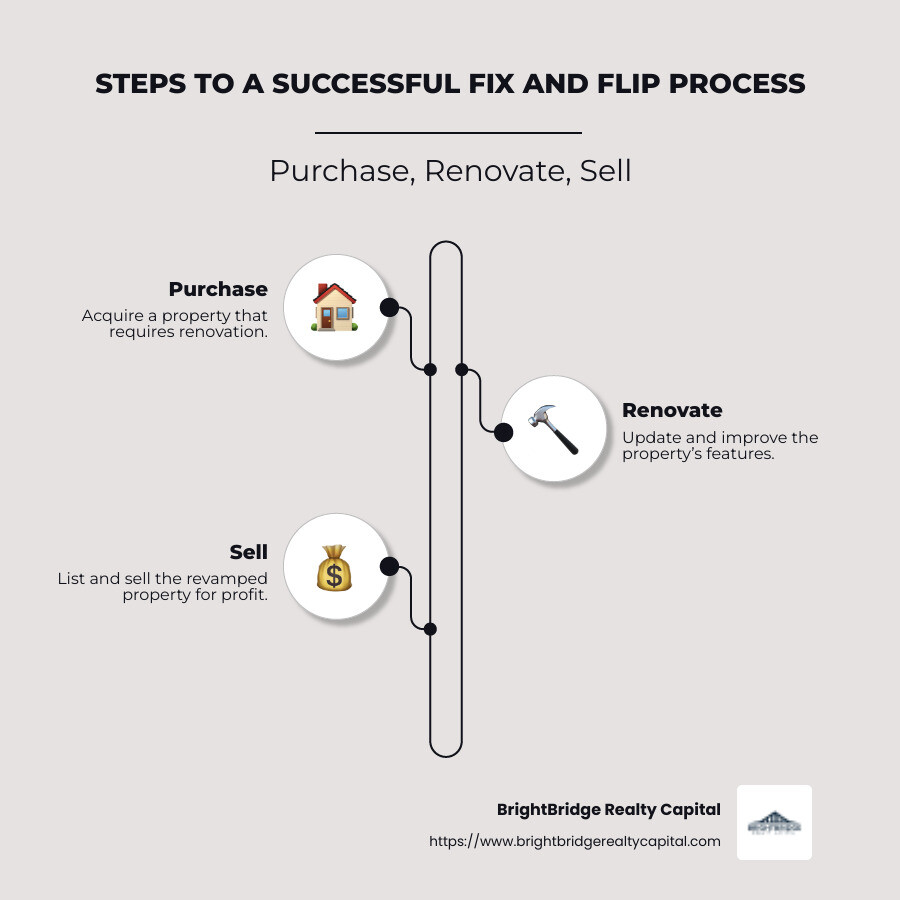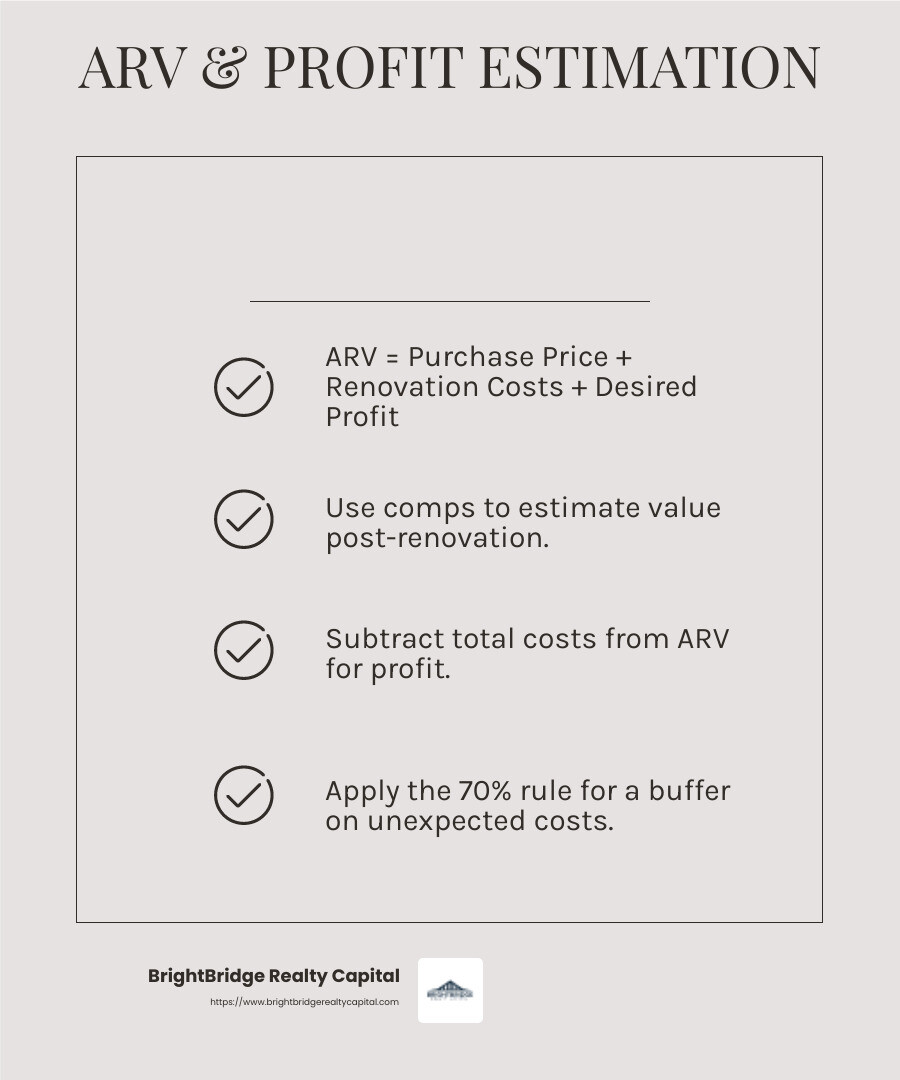The Ultimate Guide to Fix and Flip Success

Why Fix and Flip Projects Capture Investor Attention
The fix and flip process has gained popularity among real estate investors eager to transform distressed properties into profit-generating success stories. Whether you're new to real estate or a seasoned investor, understanding the fix and flip process can open the door to substantial financial rewards.
Here's a quick overview:
- Purchase: Acquire a property that requires renovation.
- Renovate: Update and improve the property’s features.
- Sell: List and sell the revamped property for profit.
The potential of fix and flip projects lies in the ability to quickly increase property value. This approach not only addresses housing shortages in certain markets but also revitalizes communities by upgrading neglected properties.
But, like any investment, flipping properties isn't without risks. Major challenges include:
- Market Fluctuations: Real estate values can shift, impacting resale prices.
- Unexpected Costs: Renovations often uncover new issues, leading to increased expenses.
- Financing Problems: Securing quick and flexible funding can be complex.
Investors can maximize their potential profit by leveraging strategic financing solutions and staying informed on market trends.

Understanding the Fix and Flip Process
Starting on the fix and flip process requires a keen understanding of market dynamics, property selection, and renovation strategies. Let's break down the essential steps to ensure your success.
Researching the Market
Before diving into a fix and flip project, thorough market research is crucial. This involves analyzing local real estate trends to identify potential opportunities and risks.
Local Trends: Understand what buyers in your area are looking for. Are open floor plans in demand? Is there a preference for modern finishes or traditional styles? Knowing these trends helps tailor renovations to meet buyer expectations.
Buyer Expectations: Use tools like the Multiple Listing Service (MLS) to get insights into what similar properties have sold for and what features they offered. This data helps set realistic goals for your project.
MLS Insights: Regularly check the MLS for recent sales data. This provides a snapshot of what buyers are willing to pay, influencing your renovation and pricing strategies.
Finding the Right Property
Once you've grasped the market, the next step is acquiring a property with potential for profit.
Distressed Properties: These are often the best candidates for flipping. They're typically priced lower due to their condition, offering room for value increase through renovations.
ARV and Comps: Calculate the After Repair Value (ARV) to estimate the property's worth post-renovation. Compare it with similar properties (comps) that have sold recently to gauge potential profit.
- ARV Formula: Estimated Selling Price = Purchase Price + Renovation Costs + Desired Profit
- Comps: Look at nearby properties with similar square footage, age, and features to determine a realistic ARV.

Renovation and Resale
After purchasing the property, the renovation phase begins. Focus on improvements that add the most value, balancing essential repairs with cosmetic upgrades.
Renovation Tips: Prioritize updates that improve the property's appeal and functionality. Kitchens, bathrooms, and curb appeal are typically high-impact areas.
Once renovations are complete, it's time to sell. Effective marketing and pricing strategies are critical to attract buyers and maximize returns.
In summary, successful fix and flip projects hinge on meticulous market research, strategic property selection, and well-planned renovations. By understanding these key components, you can steer the fix and flip process with confidence and aim for profitability.
Financing Your Fix and Flip
When it comes to house flipping, financing is a critical piece of the puzzle. Securing the right funding can make or break your project. Let's explore some popular loan options and how to calculate potential profits.
Fix and Flip Loan Options
Traditional Loans: These loans are typically offered by banks or credit unions. They're best suited for properties that don't need extensive repairs. However, they can be harder to qualify for if the property is in poor condition.
Private Money Lenders: These are individuals or groups willing to invest in your project for a return. They offer more flexibility than banks but often come with higher interest rates.
Home Equity Lines of Credit (HELOC): If you have equity in an existing property, a HELOC can provide the funds needed for your fix and flip. This option is useful if you're looking to leverage your assets without selling them.
Hard Money Loans: These are short-term loans designed for real estate investors. They offer quick funding but come with higher interest rates. They're ideal for properties needing significant renovations.
It's essential to assess your financial situation and project needs when choosing a loan. Consider factors like interest rates, loan terms, and the speed of funding.
Calculating ARV and Potential Profit
The After Repair Value (ARV) is a key metric in the fix and flip process. It estimates the property's value after renovations. Calculating ARV helps determine potential profit and guides renovation decisions.
ARV Formula: To calculate ARV, compare your property with similar recently sold homes in the area. Look at factors like size, features, and location. Use this formula:
- ARV = Purchase Price + Renovation Costs + Desired Profit
For example, if a similar home sold for $300,000, and your renovation costs are $50,000, aim for a purchase price that leaves room for profit.
Profit Estimation: Subtract the total costs (purchase price, renovation, holding costs) from the ARV to estimate your profit. A good rule of thumb is the 70% rule: aim to buy the property at 70% of the ARV minus repair costs. This leaves a buffer for unexpected expenses and ensures profitability.

In summary, successful financing and profit estimation are vital to the fix and flip process. By choosing the right loan and accurately calculating ARV, you can set your project up for success and maximize returns.
Up next, we'll dive into renovation strategies to ensure maximum ROI on your fix and flip.
Renovation Strategies for Maximum ROI
Renovation is where the magic happens in the fix and flip process. A well-executed renovation plan can turn a distressed property into a buyer's dream. Let's explore how to create a renovation plan and manage contractors effectively to maximize your return on investment (ROI).
Creating a Renovation Plan
Scope of Work: Start by defining the scope of work. This is your roadmap for the renovation. It outlines every task that needs to be completed, from essential repairs to cosmetic upgrades. Ask yourself:
- Will it add value?
- Is it cost-effective?
- Is it necessary?
Essential Repairs: Focus first on essential repairs that ensure the property is safe and functional. This includes fixing structural issues, plumbing, and electrical systems. These are non-negotiable and should be prioritized.
Cosmetic Upgrades: Once the essentials are covered, move on to cosmetic upgrades. These are the changes that improve the property's appeal, like fresh paint, modern fixtures, and updated kitchens and bathrooms. These upgrades can significantly boost the property's value without breaking the bank.
ROI Focus: Always keep ROI in mind. Choose renovations that are popular with buyers in your area. For example, a modern kitchen or a well-designed bathroom often provides a high return. Avoid over-improving the property—adding luxury features that aren't common in the neighborhood may not yield a good return.
Budget Management: Keep a tight rein on your budget. Be specific and realistic about costs from the start. Decide where to splurge and where to save. For instance, you might choose high-quality countertops for the kitchen but opt for budget-friendly flooring.
Managing Contractors Effectively
Finding and managing the right contractors is crucial to keeping your project on track.
Contractor Selection: Start by obtaining multiple quotes. This gives you a sense of the going rate and helps you select a contractor who offers the best value. Don't just go for the cheapest option—consider experience, reputation, and reliability.
Quotes and References: Always check references and past work. A contractor might have a great price, but if their work quality is poor, it could cost you more in the long run. Ensure they are licensed and insured.
Project Management: Once you've selected contractors, effective management is key. Set clear expectations with a detailed contract outlining the scope of work, deadlines, and payment terms. Regularly check in on progress and address any issues promptly.
Communication: Maintain open communication. Regular updates help prevent misunderstandings and keep the project on schedule. Use project management tools or apps to track progress and budgets.
By creating a solid renovation plan and managing contractors effectively, you can maximize the ROI on your fix and flip project. Next, we’ll explore how to market and sell your flipped property for the best possible return.
Marketing and Selling the Flipped Property
Once your renovation is complete, it’s time to showcase your property to potential buyers. The aim is to attract interest quickly and achieve a profitable sale. Let’s dive into the key aspects of marketing and selling your flipped property: staging, pricing, and marketing strategies.
Staging and Pricing
Staging is all about making the property look its best. A well-staged home helps buyers envision themselves living there. Here’s how you can do it:
Highlight Strengths: Arrange furniture to showcase spacious layouts and natural light. Use neutral colors to appeal to a wide range of buyers.
Curb Appeal: First impressions matter. Ensure the exterior is clean and inviting. A manicured lawn, fresh paint, and tidy landscaping can make a big difference.
Professional Touch: If possible, hire a professional stager. They know how to create an inviting atmosphere that attracts buyers.
Next, let’s talk about pricing. Setting the right price is crucial to attracting buyers and maximizing profit. Here’s how to do it:
Comparative Market Analysis (CMA): Conduct a CMA to evaluate prices of similar properties in the area. This helps ensure your pricing is competitive.
Strategic Pricing: While it’s tempting to aim high, setting a competitive price ensures the house doesn’t linger on the market. Adjust the price if interest is low after a few weeks.
Marketing Strategies for a Quick Sale
Effective marketing ensures your property reaches the right audience. Here are some strategies to generate interest:
Professional Photography: High-quality photos make your listing stand out online. They attract more potential buyers by highlighting the property’s best features.
Online Listings: Use platforms like Zillow and Realtor.com to maximize visibility. Ensure your listing is detailed and includes all the improvements made during renovation.
Social Media: Share your listing on social media platforms like Facebook and Instagram. Use targeted ads to reach local buyers.
Open Houses: Host open houses to allow buyers to experience the property in person. This can create a sense of urgency and competition among interested parties.
Highlight Renovations: Emphasize any upgrades and key selling points in your marketing materials, such as energy-efficient features or modern finishes.
By combining effective staging, strategic pricing, and targeted marketing, you can attract buyers quickly and achieve a successful sale. Next, we’ll answer some frequently asked questions about the fix and flip process.
Frequently Asked Questions about Fix and Flip Process
What is the 70% Rule in House Flipping?
The 70% rule is a simple guideline that helps investors determine the maximum price they should pay for a property to ensure profitability. According to this rule, you should not pay more than 70% of the property's After Repair Value (ARV) minus the estimated repair costs.
Example:
- ARV: $200,000
- Estimated Repairs: $30,000
Maximum Purchase Price = ($200,000 × 70%) – $30,000 = $110,000
This rule helps investors avoid overpaying and ensures there's enough margin for profit after considering all costs. While not a strict formula, it's a helpful tool in evaluating potential deals.
Do You Need a Real Estate License to Flip Houses?
No, you don't need a real estate license to flip houses. However, having one can be beneficial. Licensed real estate brokers often have deeper market insights and can earn commissions on other real estate transactions. This can be an additional income stream while working on your flip. As Gallagher notes, "Having knowledge of what can go wrong—all the liability issues—can really help reduce your risk." Therefore, obtaining a real estate license could improve your success in the fix and flip process.
How to Find Cheap Houses to Flip?
Finding affordable properties is crucial for a successful flip. Here are some strategies:
Distressed Properties: Look for foreclosures, short sales, or probate sales. These are often priced below market value.
Multiple Listing Service (MLS): Check the MLS for listings, but remember some of the best deals might not be listed.
Drive Around: Explore neighborhoods to spot potential properties. Look for signs of neglect like overgrown lawns or boarded-up windows.
Direct Mail Marketing: Send letters to homeowners who might be interested in selling. This proactive approach can uncover hidden gems not yet on the market.
By using these strategies, you can find properties with the potential to become profitable flips. Next, we'll explore financing options to help you fund your fix and flip ventures.
Conclusion
As we wrap up our guide on the fix and flip process, it's clear that success hinges on a blend of strategic planning, market savvy, and efficient execution. At BrightBridge Realty Capital, we understand the challenges and opportunities in this dynamic field. Our mission is to provide custom, fast, and flexible financing solutions to empower real estate investors like you to thrive.
Reflection and Improvement Opportunities
Reflecting on the journey of a fix and flip project, it's crucial to continuously learn and adapt. The real estate market is ever-changing, and staying informed on local trends and buyer expectations can make a significant difference. Embracing technology, such as project management tools, can streamline renovations and maximize efficiency.
One of the most valuable lessons in the fix and flip process is the importance of a solid network. Building relationships with reliable contractors, real estate agents, and financial partners can provide support and insights that are invaluable. At BrightBridge Realty Capital, we are committed to being a part of your network, offering fast closings and direct lending that can often be secured within a week.
Opportunities for Growth
Every fix and flip project is a learning opportunity. Whether it's refining your ability to evaluate properties, improving renovation strategies, or honing your marketing techniques, there's always room for growth. Consider seeking feedback from buyers and industry peers to identify areas for improvement.
Additionally, exploring new financing options can open up possibilities for scaling your operations. BrightBridge Realty Capital offers a range of loan products custom to meet the unique needs of real estate investors. Our fix and flip loans are designed to support your goals, providing the resources you need to purchase, renovate, and sell properties swiftly and profitably.
In conclusion, the fix and flip process is both challenging and rewarding. With the right approach, tools, and partners, you can turn your vision into a profitable reality. At BrightBridge Realty Capital, we're here to help you every step of the way. Let's build a successful future together.


